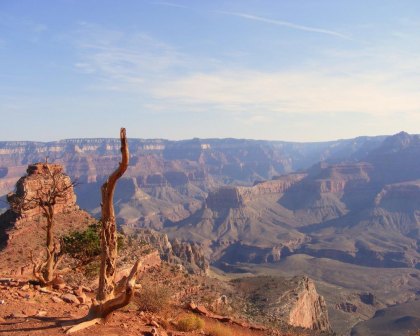Mercury formation dwarfs Grand Canyon

The valley is about 250 miles wide and 600 miles long, according to a news release from University of Maryland’s College of Computer, Mathematical & Natural Sciences. It has “steep sides that dip as much as 2 miles below the surrounding terrain.” If such a valley existed on Earth, “it would be almost twice as deep as the Grand Canyon and reach from Washington, D.C., to New York City and as far west as Detroit.”
The valley was found by scientists at the University of Maryland, the Smithsonian Institution, the German Institute of Planetary Research and Moscow State University using images from a NASA spacecraft.
Earth and Mercury developed differently, according to the university. Their lithospheres -- defined by Webster’s Dictionary as the “outer part of the solid earth composed of rock essentially like that exposed at the surface” -- are not the same. Earth has a crust and upper mantle divided into tectonic plates. Mercury has “a single, solid lithosphere that covers the entire planet,” according to the university.
“As the planet cooled and shrank early in its history, roughly 3 billion-4 billion years ago, Mercury’s lithosphere buckled and folded to form the valley, much like the skin of a grape folds as it dries to become a raisin.”
The research paper, "Fault-bound valley associated with the Rembrandt basin on Mercury," was published in Geophysical Research Letters.
THE POOP ON COOLING: Call this proof that everything has a purpose: Researchers say that bird poop helps cool the atmosphere.
Colorado State University scientists have found evidence linking “ammonia emissions from summertime Arctic seabird-colony excrement, called guano, to newly formed atmospheric aerosol particles,” according to the university. “These particles can in turn influence Arctic cloud properties and their effects on climate.”
Researchers say the birds' presence in the summer leads to "bursts of atmospheric particles linked to ammonia emissions from seabird-colony guano. These particles can spread throughout the Arctic, fostering cloud-droplet formation, and in turn reflect sunlight back to space for a net cooling effect," according to the university.
The research, “Contribution of Arctic seabird-colony ammonia to atmospheric particles and cloud-albedo radiative effect,” has been published in the journal Nature.
Related:
Global warming is already changing life
Summer to bring climate change consequences
Climate change could be fast, irreversible
If you would like to comment, give us a shout, or like us on Facebook and tell us what you think.

